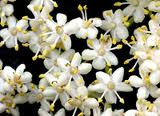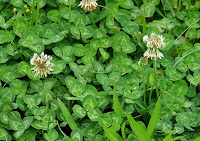There are around a hundred species of sorrel around the world, but this article centres on Common, or Garden Sorrel (Rumex acetosa), which has arrow-shaped leaves and in June and July has pink-red bell-shaper flowers. It is native to Britain and most of Europe and other varieties may be found in the US and the Indian Subcontinent as well as red sorrel (Hibiscus sabdariffa) in Jamaica and the West Indies, which is also called roselle. This is not a close relation to European sorrel. As its name suggests it is more closely related to hibiscus.
Sorrel has been known as “cuckoo’s meate”, and it is thought that it got this name because people believed that the cuckoo used it to make its voice clear. It is also known as spinach dock. It grows wild as well as in gardens, and its leaves may turn to crimson, or the veins may become a purplish colour. It looks a lot like spinach and can be used in much the same way, although it complements eggs, chicken and other poultry as well as lamb, veal and goat’s cheese.
Wood sorrel is another wild sorrel, but this is Oxalis acetosella which is to be written about in another post. There is also Mountain sorrel, (Oxyria reniformis) which can be found in parts of Wales and northern England, as well as close to the Arctic Circle, and in the Alps.
Rumex scrutatus is known as French sorrel and this is usually preferred to common Sorrel. This took over from the Common Sorrel when it was introduced into Britain in the late 16th century. Until then, Common or garden Sorrel was used for numerous dishes and in medicines. It has diuretic properties and is a coolant, and this is also true of the other sorrels including the Jamaican one which is made into a refreshing drink as are the others. Writing in 1720, John Evelyn says that sorrel “sharpens the appetite, assuages heat, cools the liver and strengthens the heart.” Culpeper agrees and states “Sorrel is prevalent in all hot diseases” and recommends it as a coolant for fevers, and all types of inflammation. He goes on to say that the roots, seeds and herb are good to treat scorpion bites, and the leaves, when heated and applied to boils caused by the plague, will burst them and so help to heal the body.
 Gerard also has a few things to say about the properties of sorrel and says “The seed of sorrel drunk in wine stoppeth the bloody flow” and continues “It cooleth a hot stomach.” He also says that the leaves were of use for “agues” or fevers.
Gerard also has a few things to say about the properties of sorrel and says “The seed of sorrel drunk in wine stoppeth the bloody flow” and continues “It cooleth a hot stomach.” He also says that the leaves were of use for “agues” or fevers. Sorrel contains Vitamin B9, Vitamin C, provitamin A, potassium, iron, calcium and magnesium, as well as fibre and carbohydrates and quercetin and lutein. It has antioxidant properties and so helps prevent the risk of heart disease and some cancers. However it is not recommended for people who have kidney or gall bladder stones or for pregnant and breast-feeding women. Children should also only be given small amounts of it- just two or three leaves, while an adult can eat 10-12 safely. The oxalic acid it contains is also not good for those who suffer from rheumatism and stones. It is a mild laxative as well as diuretic.
In the past the roots and seeds of sorrel were drunk in wine to stop haemorrhages, and the plant was used to treat scurvy, caused by vitamin C deficiency, s sorrel was used in winter months when fresh fruit and vegetables were in short supply. A decoction of the flowers in wine was used for jaundice and kidney stones.
Now sorrel is used for upper respiratory ailments and inflamed nasal passages and sinuses, and as a diuretic. The leaves and flowers can be combines in a tisane by taking a handful of them and pouring a pint of boiling water on the and leaving to steep for 10 minutes, then straining and drinking The juice of the plant may be diluted and taken orally too.
If you visit Shiraz in Iran, sorrel soup, kardeh in Farsi, is sold by street vendors in winter, to ward off colds and flu. It is widely used in Russian cuisine and there it is believed that sorrel lowers blood pressure. In France it is also widely used in omelettes, soups and green sauce to accompany fish. The young leaves can be used in salads just as spinach and dandelion leaves can. These can be substituted for sorrel and vice versa. In Ireland they use sorrel in a dish that requires fish to be poached in milk.
One of sorrel’s other names is Greensauce, and this is because it was used to make one, by pounding fresh sorrel leaves and mixing them with vinegar and sugar to serve with cold meat. The green sauce is good with turnips and spinach and also to cut the fatty flavour of roast goose and pork; this also goes well with veal and poultry, particularly chicken. You can wash sorrel leaves and shake them and simmer the leaves in their own water, then when they are ready (after 10 minutes or so) toss them in 50gr of butter. If you don’t like the acidity of the leaves you can blanch them in boiling water for a couple of minutes. The juice of the leaves can be used instead of rennet to curdle milk in the cheese-making process.
In India Indian sorrel (Oxalis corniculata) is used, boiled in buttermilk for dysentery and jaundice, and an infusion of the fresh leaves, or the fresh juice mixed with honey or sugar is given to fever sufferers. This sorrel is particularly rich in iron. The juice from the leaves is mixed with equal amounts of castor oil and given as a cure for insomnia. Water is removed by heating the mixture which is massaged into the scalp before going to bed to promote sleep and cool burning eyes.
NEW POTATOES AND SORREL
Ingredients
500 gr small new potatoes, scrubbed
100 gr sorrel leaves
50 gr butter (unsalted if possible)
1 tbsp olive oil
salt and freshly ground black pepper
Method
Boil the potatoes whole for 10-12 mins so that they are just tender.
Strip the central veins of the sorrel leaves and the shred into strips 1 cm wide.
Remove the potatoes from the heat, drain and cut in half.
Put them in a bowl with the butter and oil, and add the sorrel leaves and allow them to wilt in the heat of the potatoes.
Toss well in the butter and allow to stand for 1 or 2 minutes, and then toss well. Leave them to stand for a further minute, toss again and sprinkle with salt and pepper to taste.
This has Taste and is a Treat.











































